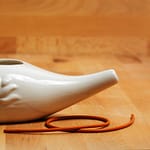Jal Neti is a nasal cleansing Yogic Kriya or action that involves the movement of lukewarm saline solution into one nostril and out the other, following which any residual water is expelled out by performing Kapalabhati.
Hatha Yoga is an important yogic practise that has long been used to overcome and heal individuals of their physical and psychological problems. Shatakarmas or the six actions/ purification processes are mentioned in the Hatha Yoga Pradipika and were practised when the Meda and Kapha were excessively present. Of the six processes, namely, Dhauti, Basti, Neti, Trataka, Nauli and Kapalabhati.
Neti can be further classified into two types Jal Neti and Sutra Neti.
While Jal Neti revolves around the flow of water through the nostrils, Sutra Neti requires the insertion of a thin surgical rubber tubing or a wet or waxed string through the nostril and into the mouth. The string or tubing is then pulled out of the mouth and held at both ends, one of the nostril and the other of the mouth. It is pulled back and forth between the two to clear the passage. Sutra Neti is an advanced practice and requires the supervision of a yogic teacher.
Neti is easier to perform and is an effective means to treat disorders such as sinusitis, eyesight issues, asthma, allergies and nasopharyngeal carcinoma and to promote mental wellbeing. It is also used to improve memory, reduce the symptoms of drowsiness, treat insomnia and alleviate pain from chronic headaches.

The Science Behind Jal Neti
Jal Neti is also referred to as Nasal irrigation and sinus flush. Nasal irrigation or Sinus flush is primarily performed to rid the individual of nasal congestion and clear the sinus passages. Nasal irrigation is performed with warm saline solution. While the salt can cause slight irritation in the nasal passage, it is recommended due to its osmotic pressure being higher than that of plain water. This means that the chances of the saltwater being absorbed into your nasal membranes are low and therefore reduces discomfort.
How Does Jal Neti Work And What Are The Steps To Perform It At Home?
Jal Neti is the simple act of letting water flow through one nostril and out the other with the help of a Neti pot. The fear associated with performing this act is justified, given that pouring water into the nostrils seems rather unnatural to begin with.
Much like every task, practice makes performing Jal Neti easier over time. A few steps need to be kept in mind while performing Jal Neti and they are simple enough to follow.
1. Preparing The Saline Solution Or Water For Neti
A teaspoon of salt must be added into two cups of warm water and stirred until fully dissolved. This solution must then be poured into a Neti pot, a small vessel with a slim, elongated spout. Ensure that salt is not added directly into the Neti pot and that the water is not heated in a kettle as it may be too hot to use.
2. Stance And Posture While Performing Neti:
Jal Neti can be performed over a sink or in an open space outdoors. Bend your knees with your feet a foot apart from each other and slightly lean forward in a comfortable position.
To start with, check both your nostrils and begin with the one that feels less congested than the other. For most people, it is usually the right nostril.
If you are starting with the right nostril, tilt your head to the left. Become aware of your breathing and start breathing from your mouth. Do not inhale from your nose. Gently tilt the spout of the Neti pot into your nostril and relax while you allow the water to flow in and come out of the other. Ensure that you do not inhale through your nose during this process.
Once you are done with one nostril, wipe it down with a towel and forcefully exhale a few times to expel the water from your nose. Begin with the other nostril and repeat the same process.
This can be done two to three times depending on the duration of the flow of water. Once you have completed performing the procedure, proceed to perform Kapalabhati. Ensure that no residual water is left behind as it may flow out of your nostrils after a while or cause discomfort.
This post was originally posted on honeyfurforher.com. If it appears in newsedigital.com, it is a violation of copywrite owned by honeyfurforher.com.
3. Forceful expulsion of water in Jal Neti:
Do not use a lot of forced breaths to expel the water out of the nostrils. And while doing so, ensure that you are still inhaling from the mouth. Use of excessive force while doing so will force the water into the ears.
What Kind Of Pot Should I Use?

Jal Neti pots are made of various materials ranging from stainless steel and copper to porcelain or plastic. Find one that is comfortable to hold and with a spout that is not too long or too short. Ensure that the size of the spout opening does not make it difficult to perform the procedure. Spouts with cone tips plug the nostril and do not allow for backflow. Although it depends on one’s personal preference and comfort level.
When Should One Practice Jal Neti?
Neti can be practised daily. If not, one can practice it three to four times a week or during seasonal changes. It can be performed when one feels like the nasal passages are congested and when one experiences discomfort.
The best time to perform Jal Neti is in the mornings before performing Pranayama. It can also be performed in the evenings when one has completed his tasks for the day.
Can You Do Jal Neti With Cold Water?
It is recommended to not use cold water for Neti as its cold temperature can further clog the nasal cavity. The water should be warm (not too hot, not too cold) so I can unclog the nasal cavity.
Health Benefits Of Neti
Jal Neti For Tinnitus
Jal Neti is deemed effective in treating tinnitus. Tinnitus is a condition where there is is a constant buzzing or ringing sound in the ear usually caused due to old age, injury or any disorder of the circulatory system. Tinnitus can be caused due to aggravation of Vata which negatively affects the auditory nerves in the ear.
The ringing or buzzing sound can be due to a change in pressure or continuous expansion of the eustachian tube that connects the middle ear to the nasopharynx. Regular Jal Neti can alleviate the symptoms and provide relief to the patient from the phantom sounds.
Jal Neti For Eyesight
Jal Neti therapy in combination with other yogic therapies such as Trataka, Shitali Pranayama, Nadishodhana Prayanama shows improvement in cases of Myopia. Regular practice of Jal Neti significantly reduces eye strain, redness in the eye and even eye pain. It also promotes vision health by ensuring the proper functioning of the tear ducts and eye lubrication.
Results are generally observed after a period of three months of regular Jal Neti practice.
Jal Neti For Nasal Polyps, Nasal Congestion, Asthma And Deviated Septum
Jal Neti might be difficult to practice for those with deviated septums. However, on trying a few times and finding a comfortable angle for the flow of water, it becomes easier to perform. It is recommended that it is tried in the presence of a Yogic instructor to ensure that the entire process is well-guided and is a comfortable experience.
After all, Neti is a technique to free up clogged or blocked nasal pathways to ensure that there isn’t a difficulty in breathing. It would be recommended that it be corrected after consultation with a physician but the technique must be practised post healing to ensure that the passages are not constricted.
Neti is used to expel out allergens, excess mucous, blockages, dust particles and such and when practised regularly, it helps treat Asthma and nasal congestion.
In the case of polyps, Jal Neti can be used to restore the integrity of the Nasal membrane and some practitioners of the Jal Neti technique report that they find it soothing.
Care must also be taken in the concentration of salt in the solution used for Neti. Excessive salt can irritate the membrane as well and must be mixed only in recommended ratios. In case polyps are caused due to other complications, the physician must be consulted before adopting the Jal Neti practice.
Ear Infections Due To Jal Neti?
It is possible that an individual may have ear infections due to the practice of Jal Neti. This usually occurs when the individual fails to perform Jal Neti properly. One must see to it that the water is expelled out of the nose. Use of excessive force can lead to the water being expelled into the ear, thus leading to an infection. The Jal Neti technique is safe to use as long as one performs it correctly.
Side Effects And Contraindications
Jal Neti is not to be recommended for those with elevated levels of blood pressure as they are prone to dizziness when performing expulsion techniques. Pregnant women cannot perform Kapalabhati and must not practice Jal Neti. It is also not advisable for children below the age of 10 years.
It is recommended that one performs Jal Neti under the guidance of a certified Yogic practitioner for the first few times or until he/she fully grasps the method.
It is also highly recommended to consult a medical practitioner to deem the individual fit to practice Jal Neti.
Did you find this post useful? Would you like to get back to it later? Save THIS PIN below to your Pinterest Yoga or Ayurveda board!
